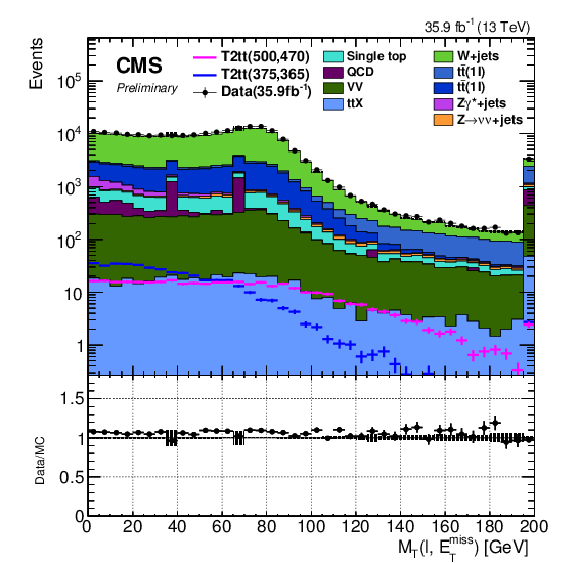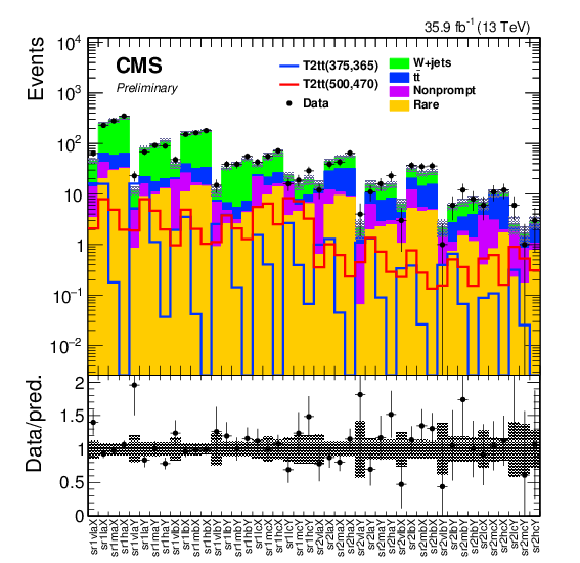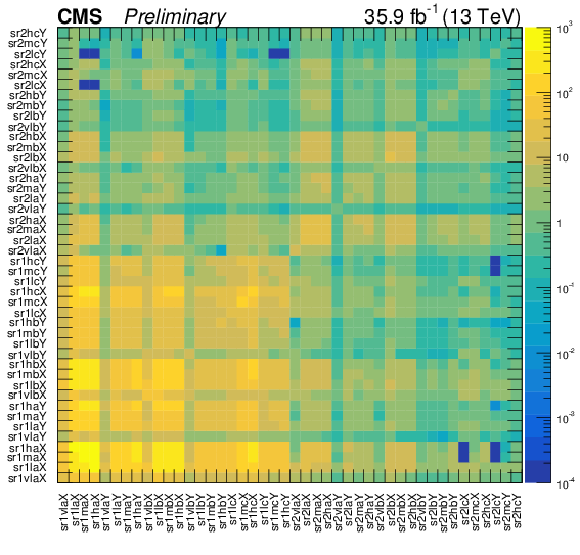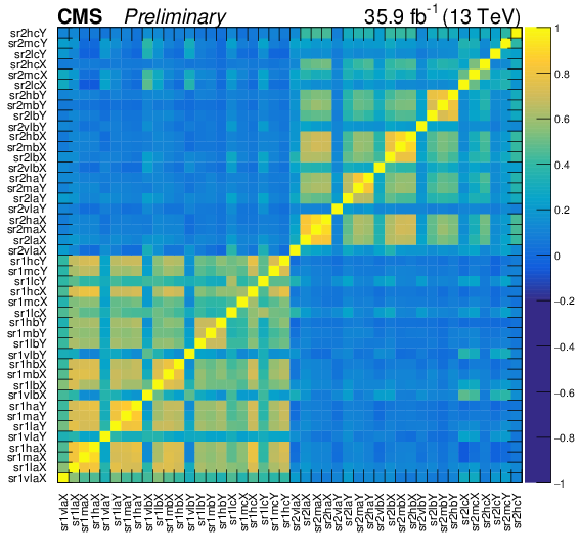

Compact Muon Solenoid
LHC, CERN
| CMS-PAS-SUS-16-052 | ||
| Search for supersymmetry in events with at least one soft lepton, low jet multiplicity, and missing transverse momentum in proton-proton collisions at $\sqrt{s}= $ 13 TeV | ||
| CMS Collaboration | ||
| July 2017 | ||
| Abstract: A search for supersymmetry with a compressed mass spectrum using events with a high-momentum jet attributed to initial state radiation, high missing transverse momentum, and a low-momentum lepton is presented. In particular, scenarios of top squark pair production are investigated, where the mass difference to the lightest supersymmetric particle (LSP) is smaller than the mass of the W boson. The search is performed in a sample of proton-proton collisions recorded with the CMS detector at a centre-of-mass energy of 13 TeV corresponding to an integrated luminosity of 35.9 fb$^{-1}$. The results are consistent with the expectation from standard model processes and limits are set on the production cross section in the plane of the top squark vs. LSP masses. The signal models used for the interpretation of the results assume either four-body decays of the top squark, $\tilde{t} \to \mathrm{b} f f' \mathrm{LSP}$, or decays via an intermediate chargino, $\tilde{t} \to \mathrm{b} \tilde{\chi}^+_1 \to \mathrm{b} f f' \mathrm{LSP}$. Assuming a 100% branching ratio of the corresponding decay, top squark masses below 500 (540) GeV for four-body (chargino-mediated) decay are excluded at 95% confidence level for a mass difference to the LSP of about 30 GeV. These limits are currently the most stringent in the single lepton final state and are similar to those of analyses targeting other final states in this region of supersymmetry parameter space with 2016 data. | ||
| Links: CDS record (PDF) ; inSPIRE record ; CADI line (restricted) ; | ||
| Figures & Tables | Summary | Additional Figures & Tables | References | CMS Publications |
|---|
|
Additional information on efficiencies needed for reinterpretation of these results are available here. Additional technical material can be found here |
| Figures | |

png pdf |
Figure 1:
Signal models for top squark pair production with subsequent four-body (left) or chargino-mediated (right) decays. |

png pdf |
Figure 1-a:
Signal models for top squark pair production with subsequent four-body decay. |

png pdf |
Figure 1-b:
Signal models for top squark pair production with subsequent chargino-mediated decay. |

png pdf |
Figure 2:
Distributions of (left) lepton $ {p_{\mathrm {T}}} $ and (right) $ {m_\mathrm {T}} $ after the preselection. Data are indicated by dots. The background distributions from simulation are represented as filled, stacked histograms, and the shapes for two example signal points as dashed lines. The error bars and the dark, shaded bands indicate the statistical uncertainties of data and simulation, respectively. The lower panels show the ratio of data to the sum of the SM backgrounds. |

png pdf |
Figure 2-a:
Distribution of lepton $ {p_{\mathrm {T}}} $ after the preselection. Data are indicated by dots. The background distributions from simulation are represented as filled, stacked histograms, and the shapes for two example signal points as dashed lines. The error bars and the dark, shaded bands indicate the statistical uncertainties of data and simulation, respectively. The lower panel shows the ratio of data to the sum of the SM backgrounds. |

png pdf |
Figure 2-b:
Distribution of lepton $ {m_\mathrm {T}} $ after the preselection. Data are indicated by dots. The background distributions from simulation are represented as filled, stacked histograms, and the shapes for two example signal points as dashed lines. The error bars and the dark, shaded bands indicate the statistical uncertainties of data and simulation, respectively. The lower panel shows the ratio of data to the sum of the SM backgrounds. |

png pdf |
Figure 3:
Summary of observed and expected background yields in all signal regions. The vertical bars and the shaded areas represent the statistical uncertainty of the data and the total uncertainty in the prediction, respectively. The lower panel shows the ratio of data to prediction. |

png pdf root |
Figure 4:
Limits at 95% CL for the four-body decay of the top squark in the $m(\tilde{ \mathrm{ t } } )$-$\Delta m(\tilde{ \mathrm{ t } } ,\tilde{\chi}^0_1 )$ plane. The colour shading corresponds to the observed limit on the cross section. The solid (dashed) lines show the observed (expected) mass limits, derived using the expected top squark pair production cross section. The thick lines representing the central values and the thin lines the variations due to the theoretical (experimental) uncertainties. |

png pdf root |
Figure 5:
Limits at 95% CL for the chargino-mediated decay of the top squark in the $m(\tilde{ \mathrm{ t } } )$-$\Delta m(\tilde{ \mathrm{ t } } ,\tilde{\chi}^0_1 )$ plane. The colour shading corresponds to the observed limit on the cross section. The solid (dashed) lines show the observed (expected) mass limits, derived using the expected top squark pair production cross section. The thick lines representing the central values and the thin lines the variations due to the theoretical (experimental) uncertainties. |
| Tables | |

png pdf |
Table 1:
Definition of signal regions and their corresponding control regions. The subregions of signal regions are denoted by tags in parentheses described in the text. For jets, the attributes ``soft'' and ``hard'' refer to the $ {p_{\mathrm {T}}} $ ranges 30-60 GeV and $>$ 60 GeV, respectively. |

png pdf |
Table 2:
Simulated background contributions to control regions normalized to a luminosity of 35.9 fb$^{-1}$. The nonprompt contributions are estimated from data. Only statistical uncertainties are reported. |

png pdf |
Table 3:
Summary of expected background and observed data yields in the signal regions. The uncertainties on the background prediction include the statistical and systematic sources. |

png pdf |
Table 4:
Relative systematic uncertainties in % on the total background prediction in individual signal regions merged in $ {p_{\mathrm {T}}} $ . |
| Summary |
|
A search for supersymmetry with compressed mass spectra is performed in events with at least one soft lepton, moderate to high values of $ p_{\mathrm{T}}^{\text{miss}} $, and one or two hard jets, compatible with the emission of initial-state radiation. The data sample corresponds to 35.9 fb$^{-1}$ of proton-proton collisions recorded by the CMS experiment at $ \sqrt{s} = $ 13 TeV. The target of this search is the pair production of top squarks with a mass splitting of at most 80 GeV with respect to the LSP. At small mass splitting, lepton momenta are low, and the b jets do not enter the acceptance. At higher values of ${\Delta m} $, the average lepton momentum increases and soft b jets can be reconstructed. Therefore, signal regions are divided depending on the presence or absence of a soft b-tagged jet and further sub-divided based on the the leading lepton $ p_{\mathrm{T}} $. The transverse mass of the lepton-$ p_{\mathrm{T}}^{\text{miss}} $ system is used as an additional discriminant. The main backgrounds to this search are W jets and $ \mathrm{ t \bar{t} } $ production. Contributions to the signal regions from these background sources are estimated by using data in control regions to normalize the simulated yields. These estimates are tested with data in validation regions. Background from $(\mathrm{ Z } \to \nu\nu) \mathrm{+jets}$ or multijet events with nonprompt lepton passing the analysis selection are estimated fully from data. The observations in the signal regions are compatible with the SM background predictions. In the absence of any indication of signal, cross section limits are set at 95% CL in the $\tilde{ \mathrm{t} }$-$\tilde{\chi}^0_1$ mass plane. These results are used to extract mass limits based on a reference cross section for top squark pair production and assuming a 100% branching fraction for either the four-body or the chargino-mediated decays of the $ \tilde{ \mathrm{t} } $. $ \tilde{ \mathrm{t} } $ masses of up to 500 GeV and 540 GeV are excluded at 95% confidence level for the four-body and the chargino-mediated decays respectivly. The sensitivity of this analysis exceeds that of previous single-lepton searches [52,16] and is similar to the sensitivity obtained in searches with 2016 data in other final states [18]. |
| Additional Figures | |

png pdf root |
Additional Figure 1:
Covariance matrix of the background estimates in the signal regions. |

png pdf root |
Additional Figure 2:
Correlation matrix of the background estimates in the signal regions. |

png pdf |
Additional Figure 3:
Observed significance for the four-body decay of the top squark in the $m(\tilde{ \mathrm{ t } } )$-$\Delta m(\tilde{ \mathrm{ t } } ,\tilde{\chi}^0_1 )$ plane. |

png pdf |
Additional Figure 4:
Observed significance for the chargino-mediated decay of the top squark in the $m(\tilde{ \mathrm{ t } } )$-$\Delta m(\tilde{ \mathrm{ t } } ,\tilde{\chi}^0_1 )$ plane. |

png pdf |
Additional Figure 5:
Limits at 95% CL for the four-body decay of the top squark in the $m(\tilde{ \mathrm{ t } } )$-$m(\tilde{\chi}^0_1 )$ plane. |

png pdf |
Additional Figure 6:
Limits at 95% CL for the chargino-mediated decay of the top squark in the $m(\tilde{ \mathrm{ t } } )$-$m(\tilde{\chi}^0_1 )$ plane. |

png pdf root |
Additional Figure 7:
Combined Limits at 95% CL for the four-body decay of the top squark in the $m(\tilde{\mathrm{t}})$-$\Delta m(\tilde{\mathrm{t}},\tilde{\chi}^0_1)$ plane. The correlations between the single-lepton (1$\ell$) and all-hadronic (0$\ell$) analyses have been taken into account. The colour shading corresponds to the observed limit on the cross section. The solid black (dashed red) lines show the observed (expected) mass limits of the combination of the single-lepton and all-hadronic analyses, derived using the expected top squark pair production cross section. The thick lines represent the central values and the thin lines the variations due to the theoretical (experimental) uncertainties. The blue and green dashed lines show the individual expected mass limits for the 1$\ell$ and 0$\ell$ searches, respectively. |

png pdf root |
Additional Figure 8:
Combined Limits at 95% CL for the chargino-mediated decay of the top squark in the $m(\tilde{\mathrm{t}})$-$\Delta m(\tilde{\mathrm{t}},\tilde{\chi}^0_1)$ plane. The correlations between the single-lepton (1$\ell$) and all-hadronic (0$\ell$) analyses have been taken into account. The colour shading corresponds to the observed limit on the cross section. The solid black (dashed red) lines show the observed (expected) mass limits of the combination of the single-lepton and all-hadronic analyses, derived using the expected top squark pair production cross section. The thick lines represent the central values and the thin lines the variations due to the theoretical (experimental) uncertainties. The blue and green dashed lines show the individual expected mass limits for the 1$\ell$ and 0$\ell$ searches, respectively. |
| Additional Tables | |

png pdf |
Additional Table 1:
Cut flow table for selection of signal regions with two signal points. |
|
ROOT files with efficiency maps for each simplified model and each signal region are provided in the following root files: - Four-body decay (T2tt): AccpEffMap_T2tt.root - Chargino-mediated decay (T2bW): AccpEffMap_T2bW.root |
| References | ||||
| 1 | J. Wess and B. Zumino | Supergauge transformations in four dimensions | Nucl. Phys. B 70 (1974) 39 | |
| 2 | R. Barbieri, S. Ferrara, and C. A. Savoy | Gauge models with spontaneously broken local supersymmetry | PLB 119 (1982) 343 | |
| 3 | H. P. Nilles | Supersymmetry, supergravity and particle physics | Phys. Reports 110 (1984) 1 | |
| 4 | H. E. Haber and G. L. Kane | The search for supersymmetry: Probing physics beyond the standard model | Phys. Reports 117 (1985) 75 | |
| 5 | S. Dawson, E. Eichten, and C. Quigg | Search for supersymmetric particles in hadron-hadron collisions | PRD 31 (1985) 1581 | |
| 6 | E. Witten | Dynamical breaking of supersymmetry | Nucl. Phys. B 188 (1981) 513 | |
| 7 | S. Dimopoulos and H. Georgi | Softly broken supersymmetry and SU(5) | Nucl. Phys. B 193 (1981) 150 | |
| 8 | G. R. Farrar and P. Fayet | Phenomenology of the production, decay, and detection of new hadronic states associated with supersymmetry | PLB 76 (1978) 575 | |
| 9 | R. Barbieri and G. Giudice | Upper bounds on supersymmetric particle masses | Nucl. Phys. B 306 (1988) 63 | |
| 10 | B. de Carlos and J. Casas | One-loop analysis of the electroweak breaking in supersymmetric models and the fine-tuning problem | PLB 309 (1993) 320 | hep-ph/9303291 |
| 11 | M. Dine, W. Fischler, and M. Srednicki | Supersymmetric technicolor | Nucl. Phys. B 189 (1981) 575 | |
| 12 | S. Dimopoulos and S. Raby | Supercolor | Nucl. Phys. B 192 (1981) 353 | |
| 13 | N. Sakai | Naturalness in supersymmetric GUTS | Z. Phys. C 11 (1981) 153 | |
| 14 | R. K. Kaul and P. Majumdar | Cancellation of quadratically divergent mass corrections in globally supersymmetric spontaneously broken gauge theories | Nucl. Phys. B 199 (1982) 36 | |
| 15 | C. Balazs, M. Carena, and C. E. M. Wagner | Dark matter, light stops and electroweak baryogenesis | PRD 70 (2004) 015007 | hep-ph/0403224 |
| 16 | CMS Collaboration | Search for supersymmetry in events with at least one soft lepton, low jet multiplicity, and missing transverse momentum in proton-proton collisions at $ \sqrt{s}= $ 13 TeV | CMS-PAS-SUS-16-031 | CMS-PAS-SUS-16-031 |
| 17 | ATLAS Collaboration | Search for top squarks in final states with one isolated lepton, jets, and missing transverse momentum using 36.1fb$ ^{-1} $ of $ \sqrt{13} $ TeV pp collision data with the ATLAS detector | ATLAS-CONF-2017-037 | |
| 18 | CMS Collaboration | Search for direct top squark pair production in the all-hadronic final state in proton-proton collisions at $\sqrt{s} = $ 13 TeV | CMS-PAS-SUS-16-049 | CMS-PAS-SUS-16-049 |
| 19 | ATLAS Collaboration | Search for direct top squark pair production in final states with two leptons in $ \sqrt{s} = $ 13 TeV pp $ collisions with the ATLAS detector | ATLAS-CONF-2017-034 | |
| 20 | CMS Collaboration | The CMS experiment at the CERN LHC | JINST 3 (2008) S08004 | CMS-00-001 |
| 21 | CMS Collaboration | Particle-flow reconstruction and global event description with the CMS detector | Submitted to JINST | CMS-PRF-14-001 1706.04965 |
| 22 | M. Cacciari, G. P. Salam, and G. Soyez | The anti-$ k_t $ jet clustering algorithm | JHEP 04 (2008) 063 | 0802.1189 |
| 23 | CMS Collaboration | Jet algorithms performance in 13 TeV data | CMS-PAS-JME-16-003 | CMS-PAS-JME-16-003 |
| 24 | CMS Collaboration | Jet energy scale and resolution in the CMS experiment in pp collisions at 8 TeV | JINST 12 (2017), no. 02, P02014 | CMS-JME-13-004 1607.03663 |
| 25 | CMS Collaboration | Performance of missing energy reconstruction in 13 TeV pp collision data using the CMS detector | CMS-PAS-JME-16-004 | CMS-PAS-JME-16-004 |
| 26 | CMS Collaboration | Identification of $ \mathrm{b }-quark $ jets with the CMS experiment | JINST 8 (2013) P04013 | CMS-BTV-12-001 1211.4462 |
| 27 | CMS Collaboration | Identification of $ \mathrm{b }\ $ quark jets at the CMS Experiment in the LHC Run 2 | CMS-PAS-BTV-15-001 | CMS-PAS-BTV-15-001 |
| 28 | CMS Collaboration | Reconstruction and identification of $ \tau $ lepton decays to hadrons and $ \nu_{\tau} $ at CMS | JINST 11 (2016), no. 01, P01019 | CMS-TAU-14-001 1510.07488 |
| 29 | CMS Collaboration | Performance of reconstruction and identification of tau leptons in their decays to hadrons and tau neutrino in LHC Run-2 | CMS-PAS-TAU-16-002 | CMS-PAS-TAU-16-002 |
| 30 | CMS Collaboration | Performance of electron reconstruction and selection with the CMS detector in proton-proton collisions at $ \sqrt{s} $ = 8 TeV | JINST 10 (2015) P06005 | CMS-EGM-13-001 1502.02701 |
| 31 | CMS Collaboration | Performance of CMS muon reconstruction in $ \mathrm{ p }\mathrm{ p } $ collision events at $ \sqrt{s} = $ 7 TeV | JINST 7 (2012) P10002 | CMS-MUO-10-004 1206.4071 |
| 32 | J. Alwall et al. | The automated computation of tree-level and next-to-leading order differential cross sections, and their matching to parton shower simulations | JHEP 07 (2014) 079 | 1405.0301 |
| 33 | NNPDF Collaboration | Parton distributions for the LHC Run II | JHEP 04 (2015) 040 | 1410.8849 |
| 34 | S. Alioli, P. Nason, C. Oleari, and E. Re | NLO single-top production matched with shower in POWHEG: s- and t-channel contributions | JHEP 09 (2009) 111 | 0907.4076 |
| 35 | E. Re | Single-top Wt-channel production matched with parton showers using the POWHEG method | EPJC71 (2011) 1547 | 1009.2450 |
| 36 | T. Sjostrand, S. Mrenna, and P. Skands | PYTHIA 6.4 physics and manual | JHEP 05 (2006) 026 | hep-ph/0603175 |
| 37 | T. Sjostrand, S. Mrenna, and P. Z. Skands | A Brief Introduction to PYTHIA 8.1 | CPC 178 (2008) 852--867 | 0710.3820 |
| 38 | GEANT4 Collaboration | GEANT4---a simulation toolkit | NIMA 506 (2003) 250 | |
| 39 | CMS Collaboration | The fast simulation of the CMS Detector at LHC | J. Phys. Conf. Ser. 331 (2011) 032049 | |
| 40 | M. Cacciari, G. P. Salam, and G. Soyez | FastJet user manual | EPJC 72 (2012) 1896 | 1111.6097 |
| 41 | T. Junk | Confidence level computation for combining searches with small statistics | NIMA 434 (1999) 435 | hep-ex/9902006 |
| 42 | A. L. Read | Presentation of search results: the $ CL_s $ technique | JPG 28 (2002) 2693 | |
| 43 | ATLAS and CMS Collaborations, LHC Higgs Combination Group | Procedure for the lhc higgs boson search combination in summer 2011 | ATL-PHYS-PUB/2011-11, CMS NOTE 2011/005 | |
| 44 | G. Cowan, K. Cranmer, E. Gross, and O. Vitells | Asymptotic formulae for likelihood-based tests of new physics | EPJC 71 (2011) 1554 | 1007.1727 |
| 45 | CMS Collaboration | CMS Luminosity Measurements for the 2016 Data Taking Period | CMS-PAS-LUM-17-001 | CMS-PAS-LUM-17-001 |
| 46 | W. Beenakker, R. Hopker, M. Spira, and P. M. Zerwas | Squark and gluino production at hadron colliders | Nucl. Phys. B 492 (1997) 51 | hep-ph/9610490 |
| 47 | A. Kulesza and L. Motyka | Threshold resummation for squark-antisquark and gluino-pair production at the LHC | PRL 102 (2009) 111802 | 0807.2405 |
| 48 | A. Kulesza and L. Motyka | Soft gluon resummation for the production of gluino-gluino and squark-antisquark pairs at the LHC | PRD 80 (2009) 095004 | 0905.4749 |
| 49 | W. Beenakker et al. | Soft-gluon resummation for squark and gluino hadroproduction | JHEP 12 (2009) 041 | 0909.4418 |
| 50 | W. Beenakker et al. | Squark and gluino hadroproduction | Int. J. Mod. Phys. A 26 (2011) 2637 | 1105.1110 |
| 51 | M. Kramer et al. | Supersymmetry production cross sections in $ \mathrm{ p }\mathrm{ p } $ collisions at $ \sqrt{s} = $ 7 TeV | 1206.2892 | |
| 52 | CMS Collaboration | Search for supersymmetry in events with soft leptons, low jet multiplicity, and missing transverse energy in proton proton collisions at $ \sqrt{s} = $ 8 TeV | PLB759 (2016) 9--35 | CMS-SUS-14-021 1512.08002 |

|
Compact Muon Solenoid LHC, CERN |

|

|

|

|

|

|